After the post about fermentation, especially on the role of yeasts, I invite you on a little journey through history, to discover what people thought in the past about this crucial passage and how mankind came to understand it.
Fermentation has been used by man for at least 10,000 years for the production of beverages and foods: wine, beer, bread, yoghurt, cheese … However, for millennia, humanity has done it without knowing how and why.
The word fermentation is ancient, derives from the Latin fermentum, from the root of the verb fervere which means to move, to boil. It arises from the observation of what is clearly visible: the bread leaven, swell and expand, the wine (or beer) boils.
But what did people think in the past of this phenomenon?
If we look for references in agrarian texts, from antiquity to the nineteenth century we don’t try hypothesis or questions about why and how it happens. Rather there are indications of practical work, useful to favor the process. This is natural: the agrarian texts in the past were mostly aimed at workers (of a certain rank), in particular the farmers. In the most ancient ages the problem is completely ignored (at least, as far as we know). In the texts of the Seven-Nineteenth century the whole process is cleared with the little phrase: “(the grape-juice) boils by its nature“. So, it just happens, we’re not asking why! These questions were left more to the philosophers and then to the scientists, but we will meet them later.

One of the most detailed agrarian texts of antiquity is the De re rustica by Columella (65 AD), “On Agriculture”, which collects the sum of all the Roman agricultural knowledge. It is a text so well done and precise that it is considered by experts to be the first real agronomic treatise in history. It was so important that it remained the main reference for agronomy until the eighteenth century!
Lucius Junius Moderatus Columella lived in the 1st century AD, originally from Cadiz (present-day Spain). After a first military career in Syria, he retired to agricultural life in his estates in central Italy. He recounts that he was influenced in his interest in agriculture by his uncle, Marcus Columella, whom he describes as a cunning man and a great farmer. So his writings are not just a literary work (like other texts on agriculture at the time) but derive from direct experience, as well as from a curious mind that already appears very scientific.

Columella loves the agricultural life that he considers morally healthier than that of the city, as he tells in his work. According to him the farmer must directly manage his own farm and must have an excellent preparation on his work, based on the study of valid texts. It shows a particular sensitivity (compared to its times) on the use of servile labor.
In the parts of the work dedicated to winemaking (much smaller than the space offered on the vineyard works part), we discover that Columella don’t explain what happens in the fermenting dolium (pl. dolia: the terracotta pot used to make wine). Yet he gives many sensible advice (in light of our current knowledge) on how to work to ensure the successful of fermentation. In particular, he insists on the necessity of absolute cleaning of the cellar and of the work tools, above all of the containers where the juice and the wine will be placed. In fact, today we know that hygiene is the first fundamental requirement for producing a good wine, to avoid polluting it with micro-organisms responsible for many serious problems, as acetification, bad smells, turbidity, etc.
Columella remembers (as every good wine cellarer does today) that the preparation for the harvest must start at least a month before, with the thorough cleaning of each tool. Also he remember that the wine press must be well cleaned after each use. “The cellar must be cleansed from all grime, perfuming it with good smells, so that it is not offended by stinking or sour smell”.
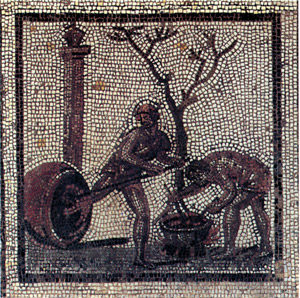
The dolia (large earthenware vases in which vinification takes place), underground or not, must be cleaned and prepared by scraping the inner pitch layer of the previous year, after having softened it with heat, and then carefully spreading again.
The following advices mainly concerns indications of “condiments” to be added to the wine (resin, sea water, etc.) for the conservation of wine. I recall that, in any case, the wines of antiquity were very different from those of today. The problems of winemaking produced wines with tastes that today we consider defects. The common use of serving them mixed with water, aromas, spices, honey and much more just served to cover and correct these inevitable problems.
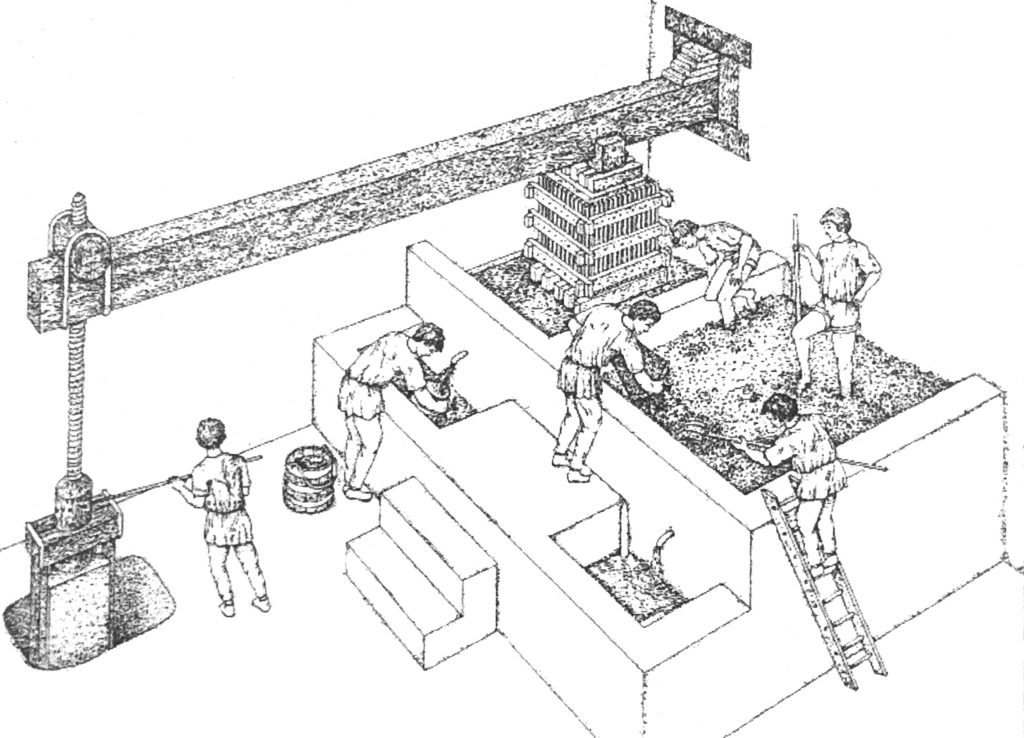
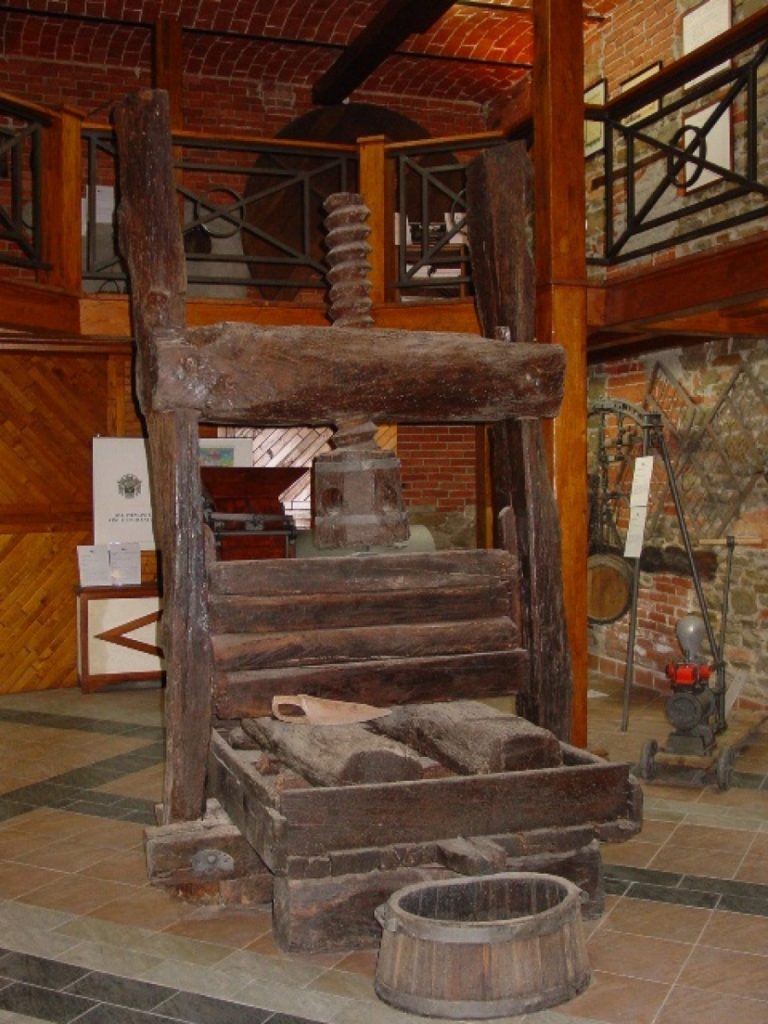
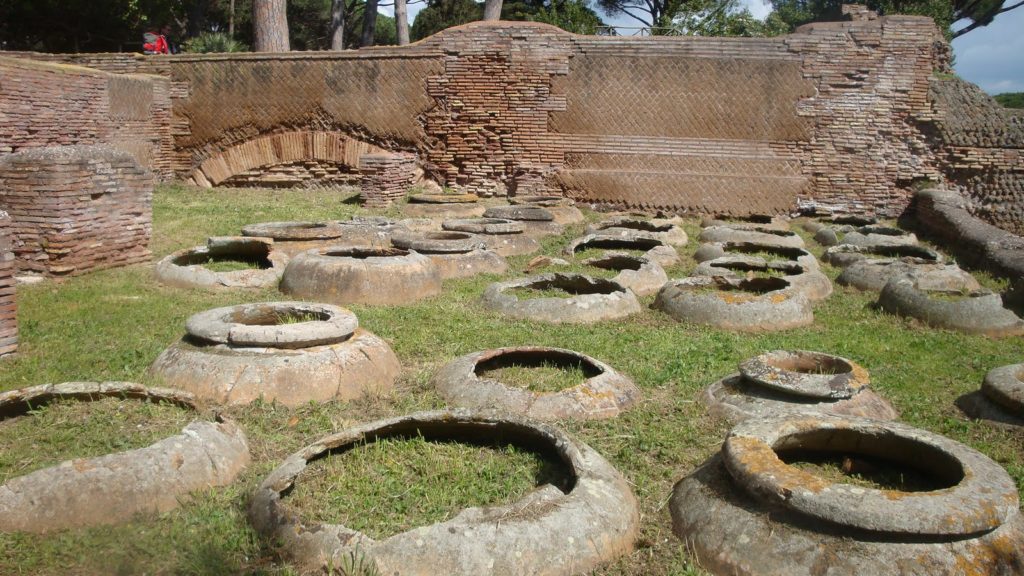
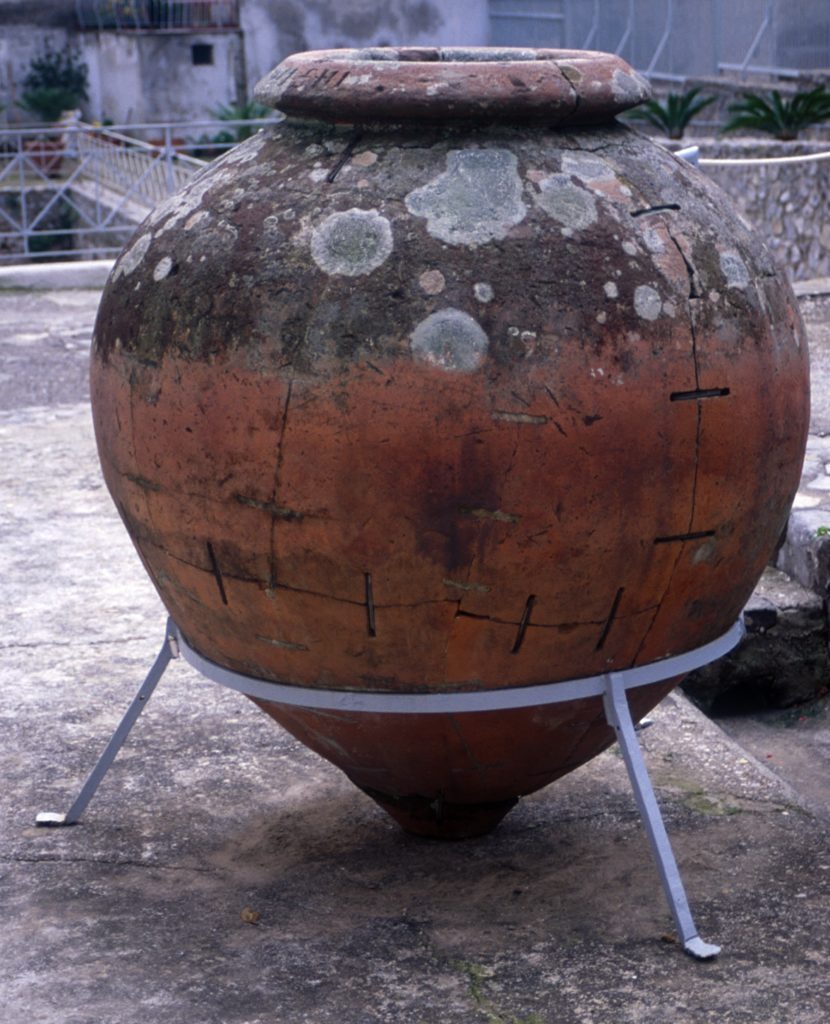
We know from more literal sources that in the ancient period it was common to attract good fortune on the harvest with augural rituals. In particular the Vinalia Rustica are celebrated on August 19th, i.e. auspicious rites for the next harvest (very similar to the blessings of the vineyards and fields that our priests did until a short time ago). Cicero, in “De Devinatione” cites the auguratio vineta, auspicious practices that traces back to the augur Attius Navius, at the time of Lucius Tarquinius Priscus.
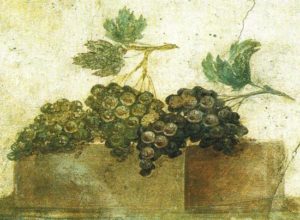
We can’t help but imagine that even the delicate phase of fermentation had its share of rituals. And yet Columella does not tell us much in this sense, hinting only rapidly at the sacrifice due to Liber and Libera, to whom the fermenting vats are to be consecrated. For him, who seems to be a curious and very rational agronomist, it is more important that “we do not go away during the harvest from the wine press or from the cellar, so that juice is clean and pure …”.
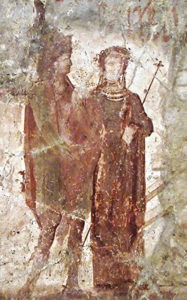
If we go to the Middle Ages, the situation does not change much. As in the late empire, there are no longer terracotta pots, but wood predominates in the cellars. However, winemaking techniques are practically the same, sometimes even with poorer techniques, especially in the early Middle Ages.
The greatest texts of medieval agronomy are above all those from Arab culture. Between the VIII and XIV centuries there is a great attention to agriculture: we count about fifty works dedicated to this field. These works flourish in all the lands under the Arab influence, in particular al-Andalus, the current Andalusia (Spain), which had a golden age in that period. For the Arab culture of the time, agriculture is a profession that requires specific knowledge. Some Andalusian texts reports agriculture as a profession (san ‘a), but also as a science (‘ilm) and an art (fann). In the work of al-Tignārī (“Book of the splendor of the garden and the delight of the mind”) it is written: “anyone who has the aptitude, has the duty to devote himself to learning the science he needs to practice his profession. Those who are deprived of this attitude, must instead resort to the advice of the wise for everything related to their crops or the products of other trades”.
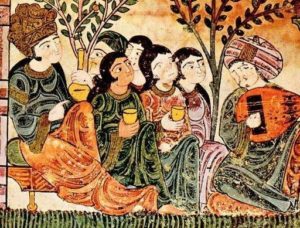
Unfortunately these texts do not speak us about wine, as it is already the Muslim era. However, they dedicate large parts to the cultivation of grapes, especially for fresh or dried consumption. Their sources are different depending on the works: some draw inspiration from classical Roman texts (above all Pliny and Columella), others from the Byzantines or ancient Mesopotamian operas. However we know, from historical and literary sources, that wine production in the viticultural territories had continued even after the passage under Arab rule. Mostly (and officially) it was carried out by communities of other religions and a small part for pharmaceutical purposes. In reality there was also a production of people of Muslim religion. The important thing was that it was not ostentatious. We know their winemaking techniques by other ways, but without sufficient details about our basic theme, fermentation. On this very interesting chapter, we will return in a next post.
Returning to the West, the only agrarian text of a certain importance is the “Ruralium Commodorum Books XII” of the Bolognese Pietro De Crescenzi (1305), based for many parts on the Latin writings, above all Columella. De Crescenzi also describes very well the phases prior to winemaking, such as the decision of the time of the harvest and the importance of cleaning the cellar, and then the subsequent ones (conservation). It does not mention the fermentation itself, but he explain how to try to remove the defects due to alterations.
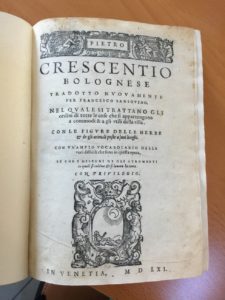
In general the author abounds with empirical advice, sometimes reasonable for us (sometimes not). In the most difficult phases, such as the alterations of the wine, which seem to go beyond the human understanding of the time, arriving as terrible as inevitable fatal events, magical and superstitious aspects increase. These parts (that will serve me as a link to talk about superstitions in winemaking), were certainly already present in the Roman agricultural world and will remain for centuries until almost to our days. Middle Ages wasn’t a darker period of many others!
But, why is wine altered? So the author explains it, in a rather obscure way (I did not find a translation in English and it is not easy to do for his archaic language and the unclear meaning of this sentence; so, it is a very free translation): “Due to its corruptible watery nature on the vine or in the vat, wine is corrupted and gone off by various causes as the strange heat. If you take off a little dregs or wine with sediment, put it in the container and then don’t open it. It would turn into mold, which infects wine. In addition to this, every other wine placed there is spoiled. And if this wine is put in a dolium and mixes with other wine, it infects it and converts it into its corrupt nature.” We know that the alterations of wine are caused by microorganisms, by oxidation or, on the lees , also for reductive phenomena. The author, obviously without knowing why, understands that it is something that happens inside, above all when wine stay long on the dregs. His considerations on the fact of not infecting a good wine with one gone bad are also important.
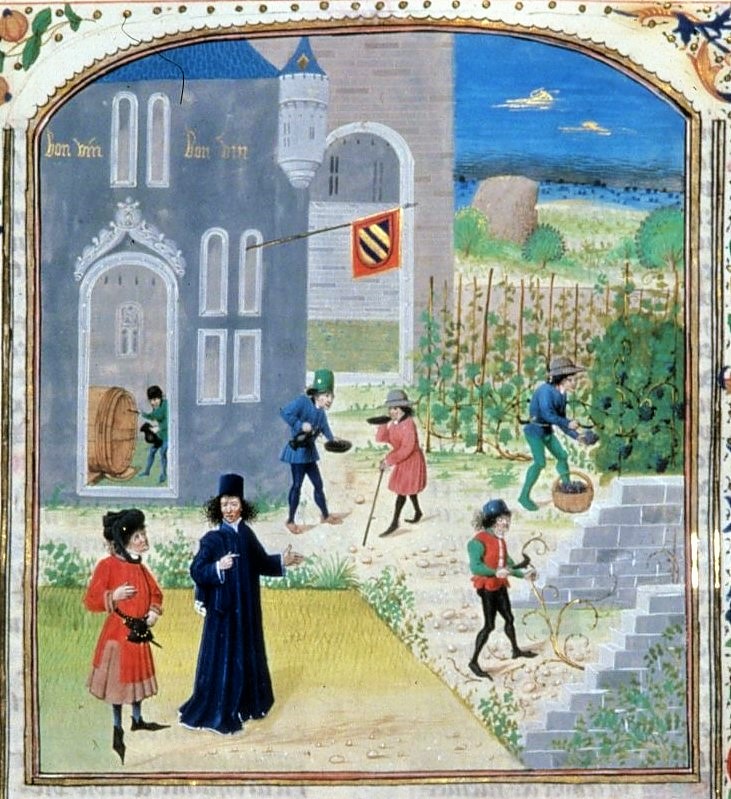
Again: “In addition, if you put the good wine, powerful and very sweet and body, during hot weather in a non-full and not closed tank, heat and damp evaporate, cold and the dry remain and wine becomes vinegar“. The vinegar taste, which (as we know) derives above all from the action of acetic bacteria, for the author is a physical phenomenon (and unclear). However, he correctly understands the danger to let a tank open and not-full (causing contact with oxygen which, we know, facilitates the development of acetic bacteria). So, he suggests the best working methods.
“Wine dà la volta (may be “tourne” disease? It is a bacterial alteration of the wine, very common in the past) and it is more easily corrupted when there is the sunset of Pleiades, in the summer solstice, in the heat of the Dog (a constellation), when it is too hot or too much frost, during the great rains, in too many winds, for earthquakes, for thunders, when roses or vines bloom “. Practically, wine alteration can occur to every particular event that “disturbs” in some way the vinification. Some listed aspects are certainly true: changes in temperature can affect what happens in the tanks. A little less other events.
This belief, regarding the fact that certain events may disturb the winemaking, are found in many rural cultures of the past, in different parts of the world (both for wine and for beer). The popular imagination has contributed to the birth of a rich and extensive casuistry, mixing intuitions of real facts (better to avoid the sudden changes in temperature) to fantastic events.
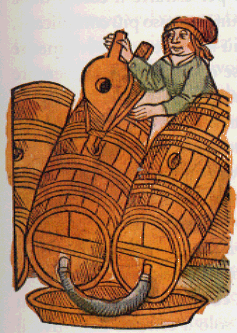
At the base is the idea that something is happening (people can see and hear it !) But is incomprehensible. Instinct leads to reverence: perhaps, if nothing disturbing happens, everything can go well… What happens, who acts? Spirits, demons, magical entities? Something is operating and so it’s forbidden to make noise, its better walking slowly, whispering, it’s forbidden to knock on the vats or barrels, to let doors or windows open , … Every territory has his stories about it. Superstition also generates terrible warnings to prevent inappropriately behavior: if a person knocks on a vat or a barrel, thus making the wine bad, he risks losing his finger or hand. It was also believed that the cellar should be kept closed to prevent evil spirits or witches or black cats from negatively influencing the process. Many other situations could be bad, like women with menstruation, who must not approach the vats. According to some peasant cultures the outcome of winemaking also is a premonitory sign of the family’s destinies. If it is not good, troubles are coming, if there are serious alterations, there could be misfortunes.
But returning to De Crescenzi, what are the remedies for the alterations of the wine? Here there is a very long list. Some practices described to prevent problems (or solve them in the early stages) are adequate, such as wine racking or keeping vats well filled and closed. When the damage is done (and even today it is almost impossible to remedy) the author lists instead a little more imaginative interventions, such as various kinds of concoctions to add to the wine, based on herbs or other. Certainly these don’t change the destiny of wine, as the author suggests, but perhaps they are more useful to cover bad smells or tastes (in the medieval period, as in the antiquity, it is a common use the correction of wines with spices, herbs, honey or other). It is also suggested the use of “magical” plants, such as the Clematis vitalba (old man’s beard) which, if placed at the base or above the cask, should prevent the wine from altering. The most curious is a sort of propitiatory rite linked to the religious sphere: an apple must be placed in the container, with a rolled-up leaflet in it: “GVSTATE ET VIDETE QVONIAM CHRISTVS SVAVIS EST DOMINVS”. (Taste and see that Christ the Lord is good).
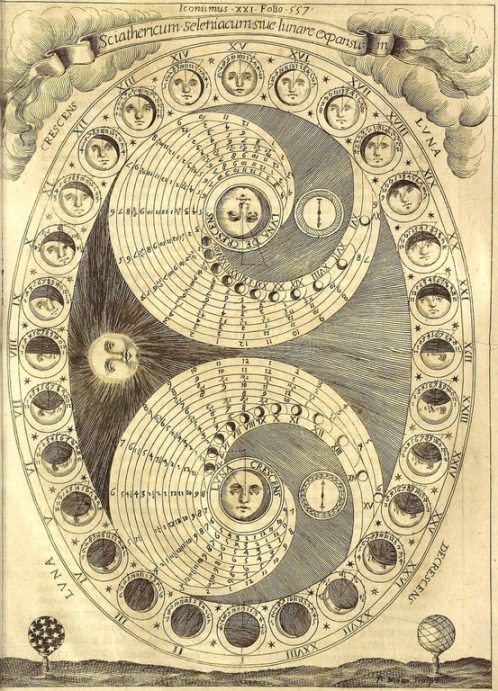
Of the beliefs mentioned by De Crescenzo, the most widespread, the most fascinating and one of the hardest to die, is the one that binds the wine to the lunar phases. According to the author, the harvest must be done during the waning moon, while the decanting with a crescent moon, otherwise the wine becomes vinegar. For example, 500 years later we find the same beliefs, as Gaetano Cantoni reported in his “Complete Agriculture Treaty” (1855) : “According to some, the moon would also influence the fermentation of manure, and consequently the dunghill should rather be turned around in the last days of the moon, because in this period less quantity of useful ingredients would dispersed, and they would remain ordered for fermentation, favored by the first quarters of the following moon. The same thing would happen for wine fermentation: about it there are the proverb that the wine made in two moons is clarified with difficulty or never “. This belief has remained until almost our days in rural culture (and not only).

These beliefs derive from the magical thought that anthropologicals have called “sympathetic magic”. One of its most important principles is that of similarity. It is based on a banal mental association whereby the similar calls the similar or where something that symbolizes a certain action has influence on it. In this conception the crescent moon is bound to all those actions or situations in which there is something that grows or has to develop or move. Instead the waning moon assumes a link with everything that decreases, which must stop or die. Therefore all the phases of agricultural harvest that involve the cutting, the death of the plant or the crushing (as for the grape), must be done in the waning moon. Instead, an action like the pouring, a movement, must be done in the crescent moon.
However, there is no need to go too far in time, these beliefs are still alive today. Magical thinking is subtle and powerful. Sometimes it is not possible to avoid it even through culture or centuries of research and scientific discoveries. The spontaneous question is: why have these beliefs survived for so long?
We must think, as described in the medieval text, that in the production of wine the magic-superstitious rituals are never done alone. They are always accompanied by good empirical practices that can lead to positive outcomes. Here, however, humanity is divided into two categories. People with a rational mind tend to think that it was good work that produced good results and focused on that. From this mental setting, over the centuries science was born. Other people instead are brought to focus their attention more on the fact that the magic has worked. Furthermore, often people makes talismanic gesture, thinking “it doesn’t hurt”! And so these beliefs are perpetuated over the centuries.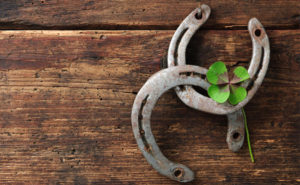
And with our knowledge of the last centuries? It seems absurd, but for some it may be easier to make sense of the simple mental correlations required by magical similitude rather than to understand the chemical or physical or physiological concepts behind certain good work practices. And then, the most important consideration of all: we like these stories!
They are beautiful, poetic, they use evocative images and words. These stories are fascinating and seductive. Also for this reason, over the centuries they have conquered and continue to this day, becoming also powerful marketing strategies of some sellers (more astute or more naive?) .
After this digression into the superstitions surrounding the winemaking, we arrive at the age of the alchemists. Thus we discover that here begin to appear the first interpretations of the real fermentation process.
(to be continued ….)
